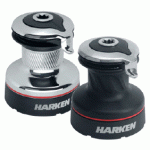Winches
Selecting the Right Winch for Your Sailboat
Choosing the correct winch is crucial for safe and efficient
sail handling. It's not a one-size-fits-all situation, and several factors
should influence your decision. Here's a focused guide to help you select the
perfect winch:
1. Determine the Load:
The most critical factor is the load the winch will handle.
This is determined by the size and type of sail, as well as the forces involved
in sheeting and trimming. Larger sails and more demanding sailing conditions
(heavy winds, racing) require winches with higher load capacities. Don't
underestimate this – an undersized winch is dangerous.
2. Winch Size and Gear Ratio:
Winch size is directly related to its load capacity.
Manufacturers provide specifications indicating the maximum load a winch can
handle. Gear ratio is also important. A lower gear ratio provides more power
for heavier loads but requires more turns. A higher gear ratio offers faster
line retrieval but less power. Two-speed winches offer the best of both worlds,
with a lower gear for initial trimming and a higher gear for quick adjustments.
3. Match the Winch to the Task:
Different winches are designed for different purposes.
Consider these common applications:
- Halyard
Winches: Used for raising and lowering sails. These often benefit from
higher gear ratios for faster hoisting.
- Sheet
Winches: Used for controlling the angle of the sails. These need to
handle higher loads and often benefit from two-speed functionality.
- Control
Line Winches: Used for adjusting various lines like topping lifts,
vangs, and outhauls. The size and type will depend on the specific
application.
4. Self-tailing vs. Non-self-tailing:
- Self-tailing:
These winches incorporate a mechanism that grips the rope, freeing up a
hand. Highly recommended for most applications, especially single-handed
sailing.
- Non-self-tailing:
These require manual rope handling, making them less convenient and
sometimes less safe. Generally only suitable for very small boats or
specific situations.
5. Material Considerations:
- Aluminum:
Lightweight and cost-effective, but less durable than other options.
- Chromed
Bronze: Durable and corrosion-resistant, a popular choice for cruising
sailboats.
- Bronze:
Traditional and aesthetically pleasing, but requires more maintenance.
6. Consult Resources:
- Manufacturer
Specifications: Always refer to the manufacturer's specifications for
detailed information on load capacity, gear ratios, and dimensions.
- Experienced
Sailors/Marine Professionals: Seek advice from experienced sailors or
marine professionals who can offer valuable insights based on your
specific boat and sailing style.
By carefully considering these factors, you can choose the
right winch size, type, and features to ensure safe and efficient sail handling
for your sailboat.



